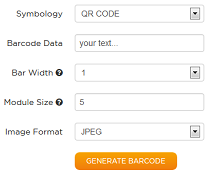Barcodes are Everywhere!
So what exactly is a barcode? A barcode is a machine readable code consisting of printed and patterned bars, spaces and geometric patterns. Barcodes (also commonly spelled “bar codes”) are used to store data and identify/track objects and assets.
The first patent for a bar code-type product was issued to inventors Joseph Woodland and Bernard Silver in 1952 and can be described as a “bull’s eye” pattern made up of concentric circles.
What are common types of barcodes? Learn four different types below:
1. Linear (1D) Barcodes

The most common barcode today is a series of parallel lines and is referred to as linear or 1D (one dimensional). Linear barcodes are most often found on consumer products in the form of a UPC, with the purpose of tracking inventory. This type of barcode can be scanned using any type of scanner, barcode reader, or even your mobile device. Have you noticed how quickly you can check out at the grocery store? Thank you, linear bar code!
2. Stacked (2D) Barcodes

A stacked or 2D (two dimensional) barcode is a group of linear barcodes stacked on top of one other, and boy, can it hold some data – up to 2500 characters, to be exact! They do not use parallel lines and can consist of rectangles, dots, hexagons and other patterns. They typically contain alpha-numeric data and must be read with a 2D barcode scanner.
3. PDF417 Barcodes
A common type of stacked barcode is the PDF417, found on the back of many states drivers’ licenses. All of the data from the front of your license is contained in the PDF417 barcode on the back. One quick read with an eCitation scanner and the data is uploaded into a computer within a matter of seconds; the Police Officer has you in the system and can quickly get you that ticket. Now that’s “great” service?!
4. QR Codes

The popular QR (Quick Response) code falls into the 2D category, as well. They are popping up everywhere – just pick up a magazine and there are bound to be QR codes in multiple advertisements. You can scan one with your mobile device, as long as the device is equipped with a camera and a QR code application. Scanning a QR code with your mobile device enables you to browse websites, initiate phone calls, send short messages, view business cards, watch videos and even make purchases. How did we survive for so long without QR codes?
5. DIY Barcodes
You can easily create QR codes, and other barcode symbologies, by using our free barcode generator tool. The barcodes listed above are among the most popular and common types out there, but with more than a dozen symbologies to choose from, how do you find the best fit for your requirement?
Some questions to consider:
- What is your application?
- How much data do you need in your barcode?
- What are your space requirements to apply a barcode?
- How will you (or others) read the barcode?
- Where will the barcode be located in your environment?
We are here to help!
Questions? Click to Contact Us.

